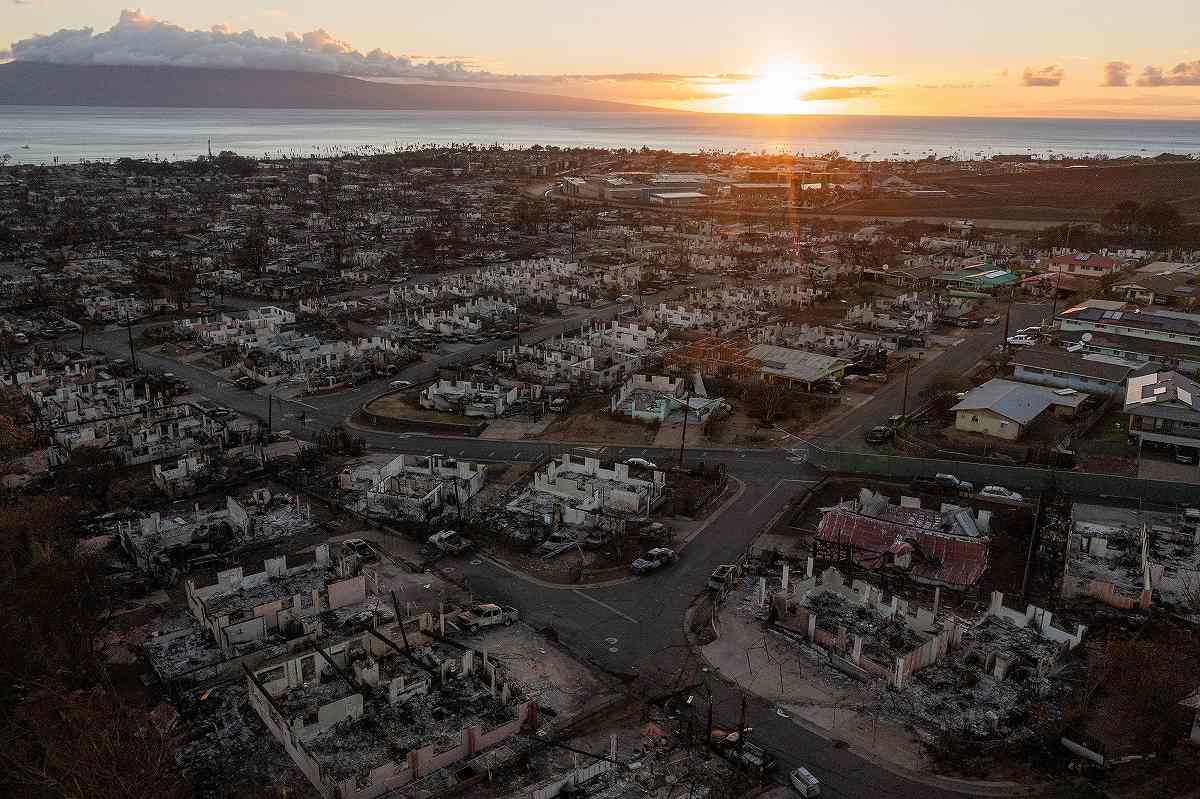
National Guard soldiers staff a checkpoint this week on Lahainaluna Road, a main thoroughfare in Lahaina, Hawaii.
17:45 JST, August 26, 2023
KAHULUI, Hawaii – Dottie Dapitan had been trying for nearly two weeks to reach the ruins of her apartment in the scorched heart of Lahaina. Maybe, she figured, some scrap remained of the existence she lost to the fire that destroyed the coastal town on Maui.
She first tried one of the many checkpoints that surround the sprawling and fortified burn zone, but National Guard troops stationed there sent her to the Maui Police Department. The police directed her to a disaster assistance center, saying Federal Emergency Management Agency staff there might arrange an escort. Those people, she had just learned, had no clue what she was talking about.
“So nobody knows how we can get to our property?” Dapitan, 67, asked some of her Lahaina neighbors as they stood outside the center this week. Dapitan and her husband had spent 25 years in the apartment, and she was desperate, she said, to “see if there’s any memories left. I just need to have some closure.”
Weeks after an inferno laid waste to Lahaina, orange-and-white jersey barriers, fences and uniformed soldiers still block nearly everyone but a select – and opaque – group of authorized visitors to the disaster area. Authorities cite potentially toxic hazards and a meticulous, ongoing search for human remains, with 341 emergency workers and 50 cadaver dog teams combing multistory and commercial buildings, having finished searching residences.
But with each passing day, frustration and heartache are rising among residents, business owners and aid workers who struggle to get straight answers about the protocol for entry – or whether one even exists – and puzzle at what has started to feel like an extended military occupation of a formerly chill beach town.
Some, like Dapitan, cite a deep emotional need to lay eyes on the places they called home. Others urgently want to check whether their fire safes, metal sculptures, coin collections or sentimental jewelry survived and have not been stolen. Aid groups want to deliver resources to the few people still living inside the burn zone or rescue animals that might be trapped in buildings.
“I’m sure the government has very good reasons,” Michael Shiffler, chief executive of Red Lightning, a nonprofit disaster aid organization, said in an interview. “It’s just frustrating for everybody. They’re trying to do the right thing, and we’re trying to do the right thing.”
Shiffler testified before the Maui County Council this week about his futile efforts to bring Starlink satellite internet systems to people living at a seaside complex that did not burn but is within the barricaded disaster area. Cell service remains spotty in Lahaina, and residents there have pleaded with his group to bring help because they are afraid to leave their homes, Shiffler said. Red Lightning resorted to meeting one resident on airport grounds north of Lahaina, teaching him there to set up the system and sending him on his way.
But at every attempt to get on an approved emergency operations center list – via the police, via the mayor’s office – Shiffler has “been turned around,” he told the council.
A council member, Gabe Johnson, sympathized. He, too, had been denied access. “It’s hard to get in there,” Johnson said.
Authorities have made clear they mean business: Last week, police arrested a 39-year-old Lahaina man found inside the zone for violating the “rules and orders” of a wildfire emergency proclamation. The man had previously entered, and been warned and escorted out, police said.
The county has also sought to quell rumors about just what is going on behind the barriers. On Wednesday, it issued a statement assuring that heavy machinery in the burn zone is, contrary to “claims circulating on social media,” being used to move debris such as cars – not to remove debris entirely.
Maui County did not respond to questions about the process or timeline for permission to enter the disaster area. But in a statement Thursday, it said that “there is no list allowing residents to return” and that neither Maui police, FEMA nor the National Guard is currently facilitating requests.
The conundrum for residents is that the message on the ground, depending on who is asked, has sometimes been the opposite.
Late Wednesday afternoon, Guard soldiers at the checkpoint on Lahainaluna Road, a main thoroughfare, told Washington Post reporters that 159 addresses were authorized for residents to visit – all homes, they said, that remain standing and have been cleared by authorities. Residents are allowed to visit, not stay, guards said. Those not on the list are directed to the police department, they said.
On that day, Sgt. Darwin Tumada said, he and his fellow guards had turned away as many as 15 families seeking to return to their homes. Safety is the reason, he told them.
“When they’re coming up, you can just see it on their faces: the sadness. They miss their homes. Their livelihood is gone,” he said. Lately, a lot of residents have been returning to the area for the first time since the destruction, he said. “It took a lot of strength for them to come here.”
One woman arrived crying, saying she hadn’t seen her grandparents since the fire and hoped to find a trace of them. Others, buckling under the weight of tremendous loss, become angry.
“It’s tough. I’ll never understand what they’re going through,” Tumada said. “Sometimes it’s best to just let them speak and get it out, to just let them lash out.”
This week, nearly two weeks after the fire, Estrelle Versola, 42, approached the Lahainaluna checkpoint, two blocks from where her house once stood. It was her first attempt at returning since Aug. 8, when she left home for work at 1 p.m., shortly before the blaze began to tear through Lahaina.
It was a house full of love, she said, which she shared with her 18-month-old, her 8-year-old, her mother, her father, her brother, his wife and that couple’s 10-year-old. The family purchased it together in 2019.
“I have my house keys,” Versola said. “I just stare at them and think about how I can’t use them anymore.”
Now Versola asked the guards if she could go to her property. The guards consulted a clipboard, then apologized. Her address was not on it. They told her to call the police department, where perhaps officials could arrange for her to return.
“Do you have a time frame?” she asked. No, the guards told her, but she could check back in a few days.
“I just want to see it,” she said, sighing.
Jennifer Rikert said she asks to enter the zone about every other day, hoping that the answer might switch from no to yes, and that she and other animal rescuers will be able to save pets they say are in houses that are standing but empty. Owners who put airtags on their pets have reported that they are remotely monitoring the animals’ movements, she said.
“They know that their cat is alive, and we’re going on week three,” said Rikert, a special-education teacher who also owns a cat boarding business and is now housing, for free, 13 cats and three giant tortoises belonging to fire evacuees. Without food or water, animals inside the disaster area won’t be able to survive much longer, she said.
Rescuers want to be allowed in, even to “throw a rock into the window and throw food in,” she said. “We have no time to go back and forth or write letters to wake up government officials.”
The county says recovery teams and other authorized personnel have been instructed to report any stray-animal sightings. That information is relayed to the Maui Humane Society so it can retrieve the animals, it said.
In the absence of permission to enter, Rikert and volunteers for other cat rescue groups, including Save Maui Cats, have been feeding and attempting to trap cats on the periphery of the burn zone. On a recent evening, they stood near a checkpoint and waited patiently for a striped cat to succumb to the scent of food they had placed inside a trap. The cat’s meows and tentative friendliness led them to believe it was a pet.
“He’s covered in ash,” Rikert said as darkness fell. “You can tell he’s been in the burn zone.”
The cat did not fall for the trap before the volunteers left to beat a 10 p.m. curfew. But they had made an ally: One of the Guard soldiers, a self-professed cat obsessive, had taken food behind the barrier and offered to monitor the trap overnight and text with any news.
Outside the assistance center, Dapitan, having run into yet another dead end, considered her options.
“I do understand the need for safety and that they’re still searching for bodies,” she said. “It’s just hard. . . . It’s like a bad dream.”
She concluded that she and her husband would simply try to drive in again, and keep trying, until they finally saw where their home once stood.
“I’ll make a run for it if I have to,” Dapitan said. “What would the bail be? It’s worth it. It means everything to me.”

A devastated neighborhood in Lahaina, as seen on Aug. 19.
"News Services" POPULAR ARTICLE
-

American Playwright Jeremy O. Harris Arrested in Japan on Alleged Drug Smuggling
-

Taiwan President Shows Support for Japan in China Dispute with Sushi Lunch
-

Japan’s Nikkei Stock Average as JGB Yields, Yen Rise on Rate-Hike Bets
-

Japan’s Nikkei Stock Average Licks Wounds after Selloff Sparked by BOJ Hike Bets (UPDATE 1)
-

Japanese Bond Yields Zoom, Stocks Slide as Rate Hike Looms
JN ACCESS RANKING
-

Japan’s Hopes for Seafood Exports Shot Down in China Spat
-

Keidanren Chairman Yoshinobu Tsutsui Visits Kashiwazaki-Kariwa Nuclear Power Plant; Inspects New Emergency Safety System
-

Japan to Charge Foreigners More for Residence Permits, Looking to Align with Western Countries
-

Japan Exports Rise in October as Slump in U.S. Sales Eases
-

Govt Aims to Expand NISA Program Lineup, Abolish Age Restriction



























